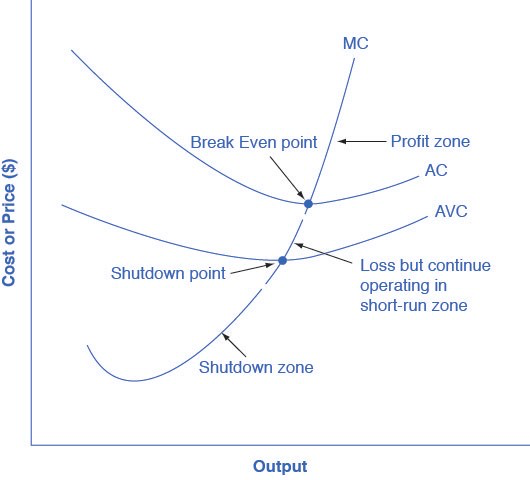Short-Run Cost Decision - Perfectly Competitive Market
How are Short-Run Decisions Based Upon Costs made in a Perfectly Competitive Market?
- Marketing, Advertising, Sales & PR
- Accounting, Taxation, and Reporting
- Professionalism & Career Development
-
Law, Transactions, & Risk Management
Government, Legal System, Administrative Law, & Constitutional Law Legal Disputes - Civil & Criminal Law Agency Law HR, Employment, Labor, & Discrimination Business Entities, Corporate Governance & Ownership Business Transactions, Antitrust, & Securities Law Real Estate, Personal, & Intellectual Property Commercial Law: Contract, Payments, Security Interests, & Bankruptcy Consumer Protection Insurance & Risk Management Immigration Law Environmental Protection Law Inheritance, Estates, and Trusts
- Business Management & Operations
- Economics, Finance, & Analytics
How are Short-Run Decisions Based Upon Costs made in a Perfectly Competitive Market?
The average cost and average variable cost curves divide the marginal cost curve into three segments.
At the market price, which the perfectly competitive firm accepts as given, the profit-maximizing firm chooses the output level where price or marginal revenue, which are the same thing for a perfectly competitive firm, is equal to marginal cost: P = MR = MC.

We can divide marginal cost curve into three zones, based on where it is crossed by the average cost and average variable cost curves.
We call the point where MC crosses AC the break even point. If the firm is operating where the market price is at a level higher than the break even point, then price will be greater than average cost and the firm is earning profits. If the price is exactly at the break even point, then the firm is making zero profits.
If price falls in the zone between the shutdown point and the break even point, then the firm is making losses but will continue to operate in the short run, since it is covering its variable costs, and more if price is above the shutdown-point price.
However, if price falls below the price at the shutdown point, then the firm will shut down immediately, since it is not even covering its variable costs.
Related Topics
- Market Structure
- Perfect Competition
- Bidding War
- Complements & Substitutes
- Substitution Effect
- Imperfect Competition
- Market Power
- Price Takers
- Price Makers
- Perfect Competition and Decision Making
- X-Efficiency
- Captive Market
- Contestable Market Theory
- Highest Profit Point in a Perfectly Competitive Market
- Marginal Revenue
- Using Marginal Revenue and Marginal Costs to Maximize Profit
- Marginal Revenue Curve
- Profit Margin and Average Total Cost
- Break Even Point - Cost Curve
- Shutdown Point - Cost Curve
- Short-Run Decisions Based Upon Costs in a Perfectly Competitive Market
- Marginal Costs and the Supply Curve for a Perfectively Competitive Firm
- Long-Run Average Supply (LRAS)
- Decisions to Enter or Exit a Market in the Long Run
- Long-Run Equilibrium in a Perfectly Competitive Market
- Constant, Increasing, and Decreasing Cost Industries
- Productive and Allocative Efficiency in Perfectly Competitive Markets
- Market Efficiency
- Market Inefficiency
- Pareto Efficiency
- Market Failure
- Search Theory
- Monopoly
- Natural Monopoly
- Legal Monopoly
- Bilateral Monopoly
- Promoting Innovation through Intellectual Property
- Predatory Pricing
- How Monopolists Set Price with the Demand Curve
- Total Cost and Total Revenue for a Monopolist
- Marginal Revenue and Marginal Cost for a Monopolist
- Inefficiency of Monopoly
- Perfectly Competitive Market
- Monopolistic Competition
- Duopoly
- Oligopoly
- Differentiated Products
- Perceived Demand for a Monopolistic Competitor
- Monopolistic Competitors Choose Price and Quantity
- Monopolistic Competitors and Entry
- Monopolistic Competition and Efficiency
- Cartel (Economics)
- Game Theory
- Traveler's Dilemma
- Prisoner's Dilemma
- Iterated Prisoner's Dilemma
- Nash Equilibrium
- Diner's Dilemma
- Trembling Hand Perfect Equilibrium
- Gambler's Fallacy
- Arrows Impossibility Theorem
- Backward Induction
- Tournament Theory
- Oligopoly and the Prisoner’s Dilemma
- Forcing Cooperation in a Prisoner’s Dilemma
- Cooperation and the Kinked Demand Curve
- Corporate Merger or Acquisition
- Antitrust Laws
- Herfindahl-Hirschman Index
- Concentration Ratio
- Other Approaches to Measuring Monopoly Power in an Industry
- Restrictive Practices under Antitrust Law
- Natural Monopoly
- Cost-Plus Regulation
- Price Cap Regulation
- Regulatory Capture